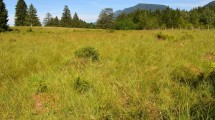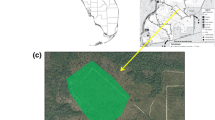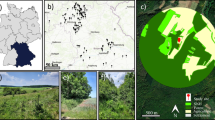Abstract
Calcareous grasslands are one of the most species-rich semi-natural habitat types. However, area and species richness have considerably decreased, particularly due to the cessation of grazing or mowing. Accordingly, habitat restoration has become an important issue in the conservation of these grasslands. The aim of this study was to analyse the role of shrub cutting as a measure to restore habitats of the target butterfly Satyrium spini (Denis and Schiffermüller 1775) on formerly abandoned calcareous grasslands. We compared host plant density and occupancy, as well as egg batch density and size between cut, regularly managed and fallow patches. In total, we counted 3372 Rhamnus cathartica host plants on 17 calcareous grassland patches. On 309 (9 %) of these plants, we found a total of 490 batches containing 1168 eggs. Both R. cathartica and S. spini responded rapidly to restoration: Shrub cutting promoted the rejuvenation of the host plant, resulting in a strong population increase of the butterfly species four years after shrub cutting. The density of the preferred small host plants (growth height < 130 cm), their occupancy, as well as the density and size of the batches on these plants, clearly exceeded those of small plants on fallow and even on traditionally managed calcareous grasslands. Based on this study, we recommend shrub cutting on calcareous grasslands as both a restorative and regular management measure for S. spini habitats. Due to the increasing demand for fuel wood, shrub cutting in overgrown grasslands might even no longer be constrained by economic reasons.


Similar content being viewed by others
References
Anthes N, Fartmann T, Hermann G, Kaule G (2003) Combining larval habitat quality and meta-population structure: the key for successful management of pre-Alpine Euphydryas aurinia colonies. J Insect Conserv 7:175–185
Anthes N, Fartmann T, Hermann G (2008) The Duke of Burgundy butterfly and its dukedom: larval niche variation in Hamearis lucina across Central Europe. J Insect Conserv 12:3–14
Bakker JP, Berendse F (1999) Constraints in the restoration of ecological diversity in grassland and heathland community. Trends Ecol Evol 14:63–68
Baur B (2014) Dispersal-limited species: a challenge for ecological restoration. Basic Appl Ecol 15:559–564
Beneš J, Konvička M, Dvořák J, Fric Z, Haveld Z, Pavlíčko A, Vrabec V, Weidenhoffer Z (eds) (2002) Motýli České republiky: Rozšíreni a ochrana [Butterflies of Czech Republic: Distribution and Conservation I]. SOM, Prague
Beneš J, Cizek O, Dovala J, Konvička M (2006) Intensive game keeping, coppicing and butterflies: the story of Milovicky Wood, Czech Republic. For Ecol Manag 237:353–365
Bourn NAD, Thomas JA (2002) The challenge of conserving grassland insects at the margins of their range in Europe. Biol Conserv 104:285–292
Carleton A, Schultz CB (2013) Restoration action and species response: oviposition habits of Plebejus icarioides fenderi (Lepidoptera: Lycaenidae) across a restoration chronosequence in the Willamette Valley, Oregon, USA. J Insect Conserv 17:511–520
Dennis RLH (2010) A resource-based habitat view for conservation: butterflies in the British landscape. Wiley, Oxford
Dennis RLH, Eales HT (1997) Patch occupancy in Coenonympha tullia (Muller, 1764) (Lepidoptera: Satyrinae): habitat quality matters as much as patch size and isolation. J Insect Conserv 1:167–176
Ebert G, Rennwald E (eds) (1991) Die Schmetterlinge Baden-Württembergs. Tagfalter II, vol 2. Ulmer, Stuttgart
EC (European Commission) (2007) Interpretation manual of European Union habitats: EUR27. European Commission, DG Environment, Brussels (Belgium)
EEA (European Environment Agency) (2005) Agriculture and Environment in EU-15: the IRENA Indicator Report. European Environment Agency, Copenhagen (Denmark)
Ehrlich PR, Hanski I (eds) (2004) On the wings of checkerspots: a model system for population biology. Oxford University Press, Oxford
Eichel S, Fartmann T (2008) Management of calcareous grasslands for Nickerl’s fritillary (Melitaea aurelia) has to consider habitat requirements of the immature stages, isolation, and patch area. J Insect Conserv 12:677–688
Fartmann T (2004) Die Schmetterlingsgemeinschaften der Halbtrockenrasen-Komplexe des Diemeltales. Biozönologie von Tagfaltern und Widderchen in einer alten Hudelandschaft. Abh Westf Mus Naturkunde 66:1–256
Fartmann T (2006) Oviposition preferences, adjacency of old woodland and isolation explain the distribution of the Duke of Burgundy butterfly (Hamearis lucina) in calcareous grasslands in central Germany. Ann Zool Fennici 43:335–347
Fartmann T, Hermann G (2006) Larvalökologie von Tagfaltern und Widderchen in Mitteleuropa: von den Anfängen bis heute. In: Fartmann T, Hermann G (eds) Larvalökologie von Tagfaltern und Widderchen in Mitteleuropa. Abh Westf Mus Naturkunde 68:11–57
Fartmann T, Timmermann K (2006) Where to find the eggs and how to manage the breeding sites of the Brown Hairstreak (Thecla betulae (Linnaeus, 1758)) in Central Europe. Nota lepidopterologica 29:117–126
Fartmann T, Müller C, Poniatowski D (2013) Effects of coppicing on butterfly communities of woodlands. Biol Conserv 159:396–404
Freese A, Beneš J, Bolz R, Cizek O, Dolek M, Geyer A, Gros P, Konvička M, Liegl A, Stettmer C (2006) Habitat use of the endangered butterfly Euphydryas maturna and forestry in Central Europe. Animal Conserv 9:388–397
García-Barros E, Fartmann T (2009) Butterfly oviposition: sites, behaviour and modes. In: Settele J, Shreeve T, Konvicka M, Van Dyck H (eds) Ecology of butterflies in Europe. Cambridge University Press, Cambridge, pp 29–42
Güthler W, Market R, Häusler A, Dolek M (2005) Vertragsnaturschutz im Wald: Bundesweite Bestandsaufnahme und Auswertung. BfN-Skripten 146:1–179
Hegi G (1975) Illustrierte Flora von Mitteleuropa. V. Band, 1. Teil: Dicotyledones, 3. Teil: Linaceae: Violaceae. Paul Parey, Berlin, Hamburg
Hermann G (2007) Tagfalter suchen im Winter: Zipfelfalter, Schillerfalter und Eisvögel [Searching for Butterflies in Winter: Hairstreaks, Purple Emperos, Poplar Admirals & White Admirals]. Books on Demand, Norderstedt
Kiehl K (2009) Renaturierung von Kalkmagerrasen. In: Zerbe S, Wiegleb G (eds) Renaturierung von Ökosystemen. Spektrum Akademischer Verlag, Heidelberg, pp 265–282
Kiehl K, Kirmer A, Donath TW, Rasran L, Hölzel N (2010) Species introduction in restoration projects: Evaluation of different techniques for the establishment of semi-natural grasslands in Central and Northwestern Europe. Basic Appl Ecol 11:285–299
Kolbeck H (2013) Kreuzdorn-Zipfelfalter Satyrium spini ([Dennis & Schiffermüller], 1775). In: Bräu M, Bolz R, Kolbeck H, Nunner A, Voith J, Wolf W (eds) Tagfalter in Bayern. Eugen Ulmer, Stuttgart, pp 224–226
Koschuh A, Savas V, Gepp J (2005) Winter-Eifunde von Zipfelfalterarten (Lepidoptera: Lycaenidae) in Graz und Umland (Steiermark, Österreich). Naturschutz Landschaftsplan 37:46–53
Kotowski W, Dzierza P, Czerwinski M, Kozub L, Snieg S (2013) Shrub removal facilitates recovery of wetland species in a rewetted fen. J Nat Conserv 21:294–308
Krämer B, Kämpf I, Enderle J, Poniatowski D, Fartmann T (2012) Microhabitat selection in a grassland butterfly: a trade-off between microclimate and food availability. J Insect Conserv 16:857–865
Kudrna O (2002) Distribution atlas of European butterflies. Oedippus 20:1–343
Kurylo JS, Knight KS, Stewart JR, Endress AG (2007) Rhamnus cathartica: native and naturalized distribution and habitat preferences. J Torrey Bot Soc 134:420–430
Littlewood NA, Stewart AJA, Woodcock BA (2012) Science into practice: how can fundamental science contribute to better management of grasslands for invertebrates? Insect Conserv Div 5:1–8
Löffler F, Stuhldreher G, Fartmann T (2013) How much care does a shrub-feeding hairstreak butterfly (Satyrium spini) need in calcareous grasslands? Eur J Entomol 110:145–152
Maes D, Jacobs I, Segers N, Vanreusel W, Van Daele T, Laurisjssens G, Van Dyck H (2014) A resource-based conservation approach for an endangered ecotone species: the Ilex Hairstreak (Satyrium ilicis) in Flanders (north Belgium). J Insect Conserv 18:939–950
Merckx T, Berwaerts K (2010) What type of hedgerows do Brown hairstreak (Thecla betulae L.) butterflies prefer? Implications for European agricultural landscape conservation. Insect Conserv Div 3:194–204
Merckx T, Huertas B, Basset Y, Thomas J (2013) A global perspective on conserving butterflies and moths and their habitats. In: Macdonald DW, Willis KJ (eds) Key topics in conservation biology 2. Wiley, Oxford, pp 237–257
Mortimer SR, Hollier JA, Brown VK (1998) Interactions between plant and insect diversity in the restoration of lowland calcareous grasslands in southern Britain. Appl Veg Science 1:10–114
Müller-Wille W (1981) Westfalen: Landschaftliche Ordnung und Bindung eines Landes, 2nd edn. Aschendorffsche Verlagsbuchhandlung, Münster
Munguira ML, García-Barros E, Martín Cano J (2009) Butterfly herbivory and larval ecology. In: Settele J, Shreeve T, Konvicka M, Van Dyck H (eds) Ecology of butterflies in Europe. Cambridge University Press, Cambridge, pp 43–54
MURL NRW (Ministerium für Umwelt, Raumordung und Landwirtschaft des Landes Nordrhein-Westfalen) (Ed.) (1989) Klima-Atlas von Nordrhein-Westfalen. Landesamt für Agrarordnung, Düsseldorf
Nitsche L, Nitsche S (2003) Naturschutzgebiete in Hessen schützen—erleben—pflegen. Band 2: Stadt Kassel, Landkreis Kassel und Schwalm-Eder-Kreis. Cognitio, Niedenstein
Poschlod P, WallisDeVries MF (2002) The historical and socioeconomic perspective of calcareous grasslands—lessons from the distant and recent past. Biol Conserv 104:361–376
Power A, Zalat S, Gilbert F (2014) Nowhere left to go: the Sinai Hairstreak Satyrium jebelia. J Insect Conserv 18:1017–1025
Reinhardt R, Bolz R (2012) Rote Liste und Gesamtartenliste der Tagfalter (Rhopalocera) (Lepitoptera: Papilionoidea et Hesperioidea) Deutschlands. In: Bundesamt für Naturschutz (ed) Rote Liste gefährdeter Tiere, Pflanzen und Pilze Deutschlands. Band 3: Wirbellose Tiere (Teil 1). Naturschutz Biol Vielfalt 70:167–194
Römermann C, Bernhardt-Römermann M, Kleyer M, Poschlod P (2009) Substitutes for grazing in semi-natural grasslands—do mowing or mulching represent valuable alternatives to maintain vegetation structure? J Veg Science 20:1086–1098
Schultz CB, Russell C, Wynn L (2013) Restoration, reintroduction, and captive propagation for at-risk butterflies: e review of British and American conservation efforts. Isr J Ecol Evol 54:41–61
Slamova I, Klecka J, Konvicka M (2013) Woodland and grassland mosaic from a butterfly perspective: habitat use by (Erebia aethiops) (Lepidoptera: Satyridae). Insect Conserv Div 6:243–254
Steiner R, Hermann G, Settele J (2007) Ökologie einer aussterbenden Population des Segelfalters Iphiclides podalirius (Linnaeus, 1758) [Ecology of an almost extinct population of the Scarce Swallowtail Iphiclides podalirius (Linnaeus, 1758).]. Invertebr Ecol Conserv Monogr 1:1–171
Stoate C, Báldi A, Beja P, Boatman ND, Herzon I, van Doorn A, de Snoo GR, Rakosy L, Ramwell C (2009) Ecological impacts of early 21st century agricultural change in Europe: a review. J Environ Manag 91:22–46
Stuhldreher G, Villar L, Fartmann T (2012) Inhabiting unusually warm microhabitats and risk-spreading as strategies of a phytophagous insect to survive in common pastures of the Pyrenees. Eur J Entomol 109:527–534
Thomas JA (1993) Holocene climate changes and warm man-made refugia may explain why a 6th of British butterflies possess unnatural early-successional habitats. Ecography 16:278–284
Thomas JA (2005) Monitoring change in the abundance and distribution of insects using butterflies and other indicator groups. Philo Trans Roy Soc B Biol Sci 360:339–357
Thomas JA, Clarke RT (2004) Extinction rates and butterflies. Science 305:1563–1564
Thomas JA, Rose RJ, Clarke RT, Thomas CD, Webb NR (1999) Intraspecific variation in habitat availability among ectothermic animals near their climatic limits and their centers of range. Funct Ecol 13(Suppl. 1):55–64
Thomas JA, Bourn NAD, Clarke RT, Stewart KE, Simcox DJ, Pearman GS, Curtis R, Goodger B (2001) The quality and isolation of habitat patches both determine where butterflies persist in fragmented landscapes. Proc Roy Soc B Biol Sci 268:1791–1796
Thomas JA, Telfer MG, Roy DB, Preston CD, Greenwood JJD, Asher J, Fox R, Clarke RT, Lawton JH (2004) Comparative losses of British butterflies, birds, and plants and the global extinction crisis. Science 303:1879–1881
van Dijk G (1991) The status of semi-natural grasslands in Europe. In: Goriup PD, Batten LA, Norton JA (eds) The conservation of lowland dry grassland birds in Europe. JNCC, Peterborough, pp 15–36
van Swaay C (2002) The importance of calcareous grasslands for butterflies in Europe. Biol Conserv 104:315–318
van Swaay C, Warren M (eds) (2003) Prime butterfly areas in Europe: priority sites for conservation. National Reference Centre for Agriculture, Nature and Fisheries, Ministry of Agriculture, Nature Management and Fisheries, Wageningen
Veen P, Jefferson R, de Smidt J, van der Straaten J (2009) Grasslands in Europe of high nature value. KNNV Publishing, Zeist
WallisDeVries MF, Poschlod P, Willems JH (2002) Challenges for the conservation of calcareous grasslands in northwestern Europe: integrating the requirements of flora and fauna. Biol Conserv 104:265–273
Watt WB, Boggs CL (2003) Synthesis: butterflies as model systems in ecology and evolution—present and future. In: Boggs CL, Watt WB, Ehrlich PR (eds) Butterflies: ecology and evolution taking flight. The University of Chicago Press, Chicago, pp 603–613
Watt AD, Bradshaw RHW, Young J, Alard D, Bolger T, Chamberlain D, Fernández-González F, Fuller R, Gurrea P, Henle K, Johnson R, Kors¢s Z, Lavelle P, Niemelä J, Norwicki P, Rebane, M, Scheidegger C, Sousa JP, van Swaay C, Vanbergen A (2007) Trends in biodiversity in Europe and the impact of land use change. In: Hester RE, Harrison RM (eds) Biodiversity under threat. Issues Environ Science Technol 25:135–160
Willems JH (1990) Calcareous grasslands in continental Europe. In: Hillier H, Walton DHW, Wells DA (eds) Calcareous grasslands. Ecology and management. Bluntisham Books, Bluntisham, pp 3–10
Woodcock BA, Bullock JM, Mortimer SR, Brereton T, Redhead JW, Thomas JA, Pywell RF (2012) Identifying time lags in the restoration of grassland butterfly communities: a multi-site assessment. Biol Conserv 155:50–58
Acknowledgments
We are very grateful to Reinhard Vollmer from Hessen Forst (Forstamt Wolfhagen) who conducted the restoration measures based on our proposal. Many thanks also to Max Freienstein, Laura Hebling, Katrin Irmscher, Cora Sonsalla, Maike Rothweiler, Martin Rudolph, Denise Rupprecht, Anuschka Tecker and Alexander Terstegge for support during field work. Moreover, we are grateful to two anonymous reviewers for valuable comments on an earlier version of the manuscript.
Author information
Authors and Affiliations
Corresponding author
Rights and permissions
About this article
Cite this article
Helbing, F., Cornils, N., Stuhldreher, G. et al. Populations of a shrub-feeding butterfly thrive after introduction of restorative shrub cutting on formerly abandoned calcareous grassland. J Insect Conserv 19, 457–464 (2015). https://doi.org/10.1007/s10841-015-9766-5
Received:
Accepted:
Published:
Issue Date:
DOI: https://doi.org/10.1007/s10841-015-9766-5




